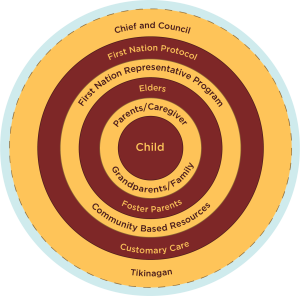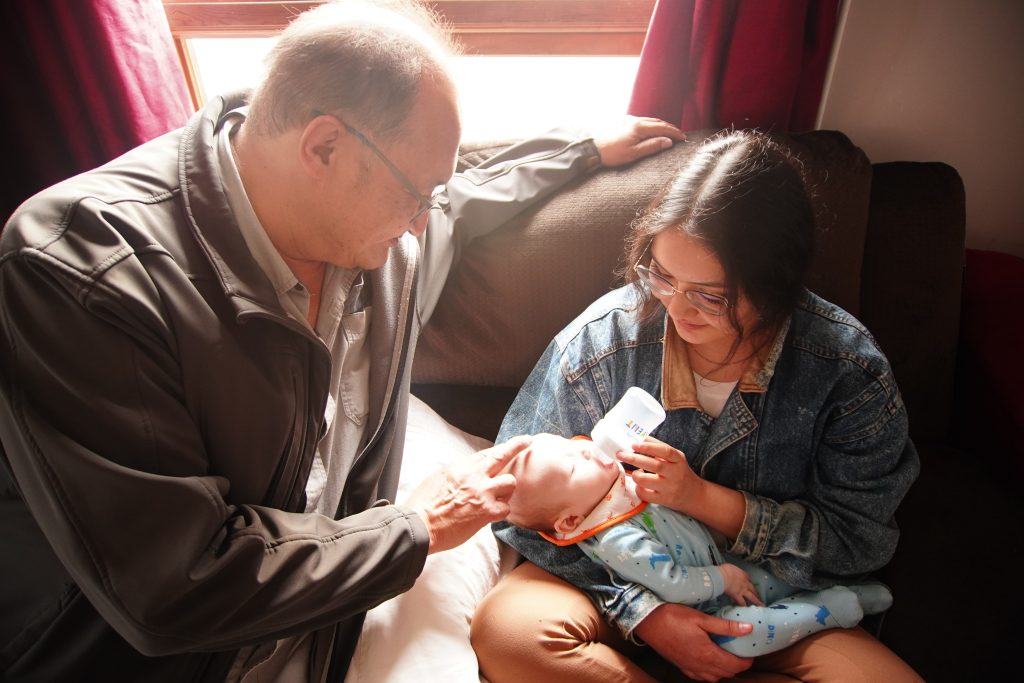ᒪᒪᐤ ᐅᐱᑭᐦᐊᐊᐧᓱᐃᐧᐣ ᓇᐣᑕ 40 ᐊᐦᑭᐃᐧᐣ ᐊᓄᑭᐃᐧᐣ ᒥᓂᑯᐠ ᐁᐃᔑᓇᑲᐧᐠ ᐁᑭ ᐅᓇᒋᑲᑌᐠ ᑫᔑ ᓇᐦᐃᓭᓂᐠ ᐊᓂᔑᓂᓂ ᑲᐃᔑ ᐊᓂᑲᐊᐧᐨ ᐊᐊᐧᔑᔕᐠ ᒥᓇ ᑎᐯᐣᒋᑫᐃᐧᓇᐣ ᑲᓇᐣᑕᐁᐧᐣᑕᒧᐊᐧᐨ ᐃᐧᒋᐦᐃᑯᐃᐧᐣ ᐃᒪ ᐊᓂᔑᓂᓂᐃᐧ ᑕᔑᑫᐃᐧᓂᐠ. ᐁᑲᐧ ᑕᐡ ᐃᐁᐧ ᑲᐅᓇᒋᑲᑌᐠ ᒪᒪᐤ ᐅᐱᑭᐦᐊᐊᐧᓱᐃᐧᐣ, ᓂᑭ ᐃᓯᓭᑐᒥᐣ ᒋᐱᒥᓂᔕᐦᐊᒪᐣᐠ ᑲᑭ ᐃᓀᐣᑕᑲᐧᑭᐸᐣ ᒋᑭ ᐃᓇᓄᑭᒪᑲᑭᐸᐣ ᑲᑭ ᐅᓇᑐᐊᐧᐸᐣ ᐅᑭᒪᑲᓇᐠ ᒥᓇ ᑭᒋᔭᐦᐊᐠ ᐊᐱ ᑎᑭᓇᑲᐣ ᑲᑭ ᐅᓇᒋᑲᑌᑭᐸᐣ.
ᐅᐁᐧ ᒪᓯᓇᐦᐃᑲᐣ ᑲᐱᒥᓂᔕᐦᐃᑲᑌᐠ ᒥᑐᓂ ᐱᑯ ᑲᐧᔭᐠ ᐃᐧᐣᒋᑫᒪᑲᐣ ᐊᓂᐣ ᑫᐃᓇᓄᑲᑌᐠ ᐅᐁᐧ ᐃᐧᒋᐦᐃᐁᐧᐃᐧ ᒪᓯᓇᐦᐃᑲᐣ, ᐊᔑᐨ ᑲᔦ ᐃᐧᒋᐦᐃᐁᐧᐃᐧᐣ ᑲᐃᔑ ᑲᓇᐊᐧᐸᐣᒋᑲᑌᐠ ᒥᓇ ᐅᓇᑯᓂᑫᐃᐧᓀᓴᐣ. ᒥᓇ ᐊᓂᐣ ᑫᑐᒋᑲᑌᑭᐣ ᐃᐧᑕᓄᑭᒥᑎᐃᐧᓇᐣ ᒥᓇ ᑲᔕᑲᐡᑭᓀᐱᐦᐃᑲᑌᑭᐣ ᐯᐸᓇᐣ. ᒪᒪᐤ ᐅᐱᑭᐦᐊᐊᐧᓱᐃᐧᐣ ᐃᓇᐦᑌ ᒋᑭᒋᓀᐣᒋᑲᑌᐠ ᐅᒪᓂᑐᐃᐧ ᐅᑐᓇᔓᐊᐧᒋᑫᐃᐧᓂᐊᐧ ᐊᓂᔑᓂᓂᐊᐧᐠ ᒋᐸᒥᓇᐊᐧᐨ ᐅᓂᒐᓂᔑᐊᐧᐣ. ᐊᒥᑕᐡ ᑲᔦ ᐁᐃᑭᑐᒪᑲᐠ ᐃᐁᐧ ᐊᓂᔑᓂᓂᐊᐧᐠ ᐅᑐᓇᔓᐊᐧᒋᑫᐃᐧᓂᐊᐧ ᐁᐸᔑᒋᐡᑭᑲᑌᓂᐠ ᐅᐣᑌᕑᐃᔪ ᐅᓇᔓᐁᐧᐃᐧᐣ ᒥᓇ ᑲᔦ ᐃᐁᐧ ᑲᑲᑫᐧ ᑌᐱᓂᑲᑌᐠ ᒥᓯᐁᐧ ᐊᓂᔑᓂᓂ ᒋᑭ ᐊᓂ ᑎᐯᐣᑕᑭᐸᐣ ᐊᐊᐧᔑᔑᐃᐧ ᐃᐧᒋᐦᐃᐁᐧᐃᐧ ᐱᒧᒋᑫᐃᐧᐣ. ᐁᑲᐧ ᑕᐡ ᐸᓂᒪ ᐅᐁᐧ ᑭᐊᓂ ᑌᐱᓂᑲᑌᐠ, ᒪᒪᐤ ᐅᐱᑭᐦᐊᐊᐧᓱᐃᐧᐣ ᐃᓇᐦᑌ ᑫᒋᓇᐨ ᑎᑭᓇᑲᐣ ᒋᐸᑭᑎᓇᒧᐊᐧᐨ ᐃᐧᒋᐦᐃᐁᐧᐃᐧᓇᐣ ᑲᐃᔑ ᓇᐣᑕᐁᐧᐣᑕᐠ ᐅᐣᑌᕑᐃᔪ ᐅᓇᔓᐁᐧᐃᐧᐣ, ᐱᒥᓂᔕᐦᐃᑫᐃᐧᐣ ᒥᓇ ᑲᐃᔑ ᓇᐣᑕᐁᐧᐣᑕᑲᐧᐠ ᒋᔑ ᑲᓇᐊᐧᐸᐣᒋᑲᑌᐠ.


 Tikinagan shares the sacred responsibility held by parents, extended family and community members to care for children. When a child comes into care, it is important for each child to be part of a network of caring people. Every person who has an interest in the care of a child is asked to become a member of the Wee-chee-way-win Circle for the child. The Wee-chee-way-win Circle may include the child’s parents and siblings, extended family members, the First Nation Chief and Council, Elders, the school principal and teachers, workers from other community resources, Foster Parents and other caregivers, and Tikinagan workers and supervisors. Although each has a different role in the Circle, the success of a child’s emotional security depends on teamwork. By working together in mutual cooperation and respect, a circle of healing will surround the child.
Tikinagan shares the sacred responsibility held by parents, extended family and community members to care for children. When a child comes into care, it is important for each child to be part of a network of caring people. Every person who has an interest in the care of a child is asked to become a member of the Wee-chee-way-win Circle for the child. The Wee-chee-way-win Circle may include the child’s parents and siblings, extended family members, the First Nation Chief and Council, Elders, the school principal and teachers, workers from other community resources, Foster Parents and other caregivers, and Tikinagan workers and supervisors. Although each has a different role in the Circle, the success of a child’s emotional security depends on teamwork. By working together in mutual cooperation and respect, a circle of healing will surround the child.

